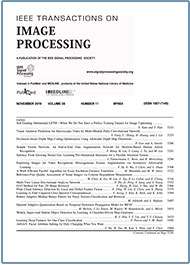- Our Story
- Publications & Resources
- Publications & Resources
- Publications
- IEEE Signal Processing Magazine
- IEEE Journal of Selected Topics in Signal Processing
- IEEE Signal Processing Letters
- IEEE Transactions on Computational Imaging
- IEEE Transactions on Image Processing
- IEEE Transactions on Information Forensics and Security
- IEEE Transactions on Multimedia
- IEEE Transactions on Signal and Information Processing over Networks
- IEEE Transactions on Signal Processing
- IEEE TCI
- IEEE TSIPN
- Data & Challenges
- Submit Manuscript
- Guidelines
- Information for Authors
- Special Issue Deadlines
- Overview Articles
- Top Accessed Articles
- SPS Newsletter
- SigPort
- SPS Resource Center
- Publications FAQ
- Blog
- News
- Dataset Papers
- Conferences & Events
- Community & Involvement
- Professional Development
- For Volunteers
- Information for Authors-OJSP
-
Home
Conferences Events IEEE Signal Processing Magazine IEEE SPL Article IEEE TIFS Article IEEE TMM Article IEEE TSP Article Jobs in Signal Processing Lectures Machine Learning Seasonal Schools Signal Processing News SPM Article SPS Distinguished Lectures SPS Newsletter Article SPS Webinar SPS Webinars SPS Webinar Series Webinar webinars
-
Our Story
What is Signal Processing?

The technology we use, and even rely on, in our everyday lives –computers, radios, video, cell phones – is enabled by signal processing. Learn More » -
Publications & Resources
-
SPS Resources
- Signal Processing Magazine The premier publication of the society.
- SPS Newsletter Monthly updates in Signal Processing
- SPS Resource Center Online library of tutorials, lectures, and presentations.
- SigPort Online repository for reports, papers, and more.
- SPS Feed The latest news, events, and more from the world of Signal Processing.
-
SPS Resources
-
Conferences & Events
-
Community & Involvement
-
Membership
- Join SPS The IEEE Signal Processing Magazine, Conference, Discounts, Awards, Collaborations, and more!
- Chapter Locator Find your local chapter and connect with fellow industry professionals, academics and students
- Women in Signal Processing Networking and engagement opportunities for women across signal processing disciplines
- Students Scholarships, conference discounts, travel grants, SP Cup, VIP Cup, 5-MICC
- Young Professionals Career development opportunities, networking
- Get Involved
-
Technical Committees
- Applied Signal Processing Systems
- Audio and Acoustic Signal Processing
- Bio Imaging and Signal Processing
- Computational Imaging
- Image Video and Multidimensional Signal Processing
- Information Forensics and Security
- Machine Learning for Signal Processing
- Multimedia Signal Processing
- Sensor Array and Multichannel
- Signal Processing for Communication and Networking
- Signal Processing Theory and Methods
- Speech and Language Processing
- Technical Working Groups
- More TC Resources
-
Membership
-
Professional Development
-
Professional Development
- Signal Processing Mentorship Academy (SigMA) Program
- Micro Mentoring Experience Program (MiME)
- Distinguished Lecturer Program
- Distinguished Lecturers
- Distinguished Lecturer Nominations
- Past Lecturers
- Distinguished Industry Speaker Program
- Distinguished Industry Speakers
- Distinguished Industry Speaker Nominations
- Industry Resources
- IEEE Training Materials
- Jobs in Signal Processing: IEEE Job Site
-
Career Resources
- SPS Education Program Educational content in signal processing and related fields.
- Distinguished Lecturer Program Chapters have access to educators and authors in the fields of Signal Processing
- Job Opportunities Signal Processing and Technical Committee specific job opportunities
- Job Submission Form Employers may submit opportunities in the area of Signal Processing.
-
Professional Development
-
For Volunteers
-
For Board & Committee Members
- Board Agenda/Minutes* Agendas, minutes and supporting documentation for Board and Committee Members
- SPS Directory* Directory of volunteers, society and division directory for Board and Committee Members.
- Membership Development Reports* Insight into the Society’s month-over-month and year-over-year growths and declines for Board and Committee Members
-
For Board & Committee Members
Popular Pages
Today's:
- Information for Authors
- Last Call for Nominations: Technical Committee Vice Chair and Member Positions
- IEEE Transactions on Information Forensics and Security
- (ASRU 2025) 2025 IEEE Automatic Speech Recognition and Understanding Workshop
- (ICME 2026) 2026 IEEE International Conference on Multimedia and Expo
- IEEE Transactions on Image Processing
- Submit a Manuscript
- IEEE Transactions on Multimedia
- IEEE Transactions on Audio, Speech and Language Processing
- Membership
- Call for Papers for ICASSP 2026 Now Open!
- IEEE Journal of Selected Topics in Signal Processing
- IEEE Signal Processing Letters
- Information for Authors-SPL
- Conference Call for Papers
All time:
- Information for Authors
- Submit a Manuscript
- IEEE Transactions on Image Processing
- IEEE Transactions on Information Forensics and Security
- IEEE Transactions on Multimedia
- IEEE Transactions on Audio, Speech and Language Processing
- IEEE Signal Processing Letters
- IEEE Transactions on Signal Processing
- Conferences & Events
- IEEE Journal of Selected Topics in Signal Processing
- Information for Authors-SPL
- Conference Call for Papers
- Signal Processing 101
- IEEE Signal Processing Magazine
- Guidelines
Last viewed:
- SPS Webinar: PhishSim: Aiding Phishing Website Detection With a Feature-Free Tool
- Editorial Board
- Distinguished Lecturers
- SPS Publications Alert: November 2019 Tables of Contents
- Sequence Design for Spectral Shaping via Minimization of Regularized Spectral Level Ratio
- Information for Authors
- Publications Board
- IEEE Transactions on Audio, Speech and Language Processing
- (SiPS 2025) 2025 IEEE International Workshop on Signal Processing Systems
- IEEE Transactions on Signal Processing
- Unified EDICS
- IEEE Transactions on Multimedia
- IEEE JSTSP Special Issue on Deep Multimodal Speech Enhancement and Separation
- JSTSP Special Issue on End-to-End Speech and Language Processing
- Last Call for Nominations: Technical Committee Vice Chair and Member Positions
Transition Is a Process: Pair-to-Video Change Detection Networks for Very High Resolution Remote Sensing Images
You are here
Publications & Resources
Transactions on Image Processing
For Authors
Top Reasons to Join SPS Today!
1. IEEE Signal Processing Magazine
2. Signal Processing Digital Library*
3. Inside Signal Processing Newsletter
4. SPS Resource Center
5. Career advancement & recognition
6. Discounts on conferences and publications
7. Professional networking
8. Communities for students, young professionals, and women
9. Volunteer opportunities
10. Coming soon! PDH/CEU credits
Click here to learn more.
Transition Is a Process: Pair-to-Video Change Detection Networks for Very High Resolution Remote Sensing Images
As an important yet challenging task in Earth observation, change detection (CD) is undergoing a technological revolution, given the broadening application of deep learning. Nevertheless, existing deep learning-based CD methods still suffer from two salient issues: 1) incomplete temporal modeling, and 2) space-time coupling. In view of these issues, we propose a more explicit and sophisticated modeling of time and accordingly establish a pair-to-video change detection (P2V-CD) framework. First, a pseudo transition video that carries rich temporal information is constructed from the input image pair, interpreting CD as a problem of video understanding. Then, two decoupled encoders are utilized to spatially and temporally recognize the type of transition, and the encoders are laterally connected for mutual promotion. Furthermore, the deep supervision technique is applied to accelerate the model training. We illustrate experimentally that the P2V-CD method compares favorably to other state-of-the-art CD approaches in terms of both the visual effect and the evaluation metrics, with a moderate model size and relatively lower computational overhead. Extensive feature map visualization experiments demonstrate how our method works beyond making contrasts between bi-temporal images. Source code is available at https://github.com/Bobholamovic/CDLab.
Change detection (CD) aims at identifying changes occurring between two or more images acquired in the same geographical area at different times [1] and has long been a topic of immense interest in remote sensing. A typical CD model accepts a bi-temporal image pair and predicts a change map that delineates the change type at each pixel, expressed as either change or no-change in a binary CD problem. CD plays a role in a wide array of applications including damage assessment [2], urban studies [3], ecosystem monitoring [4], agricultural surveying [5], and resource management [6].
SPS Social Media
- IEEE SPS Facebook Page https://www.facebook.com/ieeeSPS
- IEEE SPS X Page https://x.com/IEEEsps
- IEEE SPS Instagram Page https://www.instagram.com/ieeesps/?hl=en
- IEEE SPS LinkedIn Page https://www.linkedin.com/company/ieeesps/
- IEEE SPS YouTube Channel https://www.youtube.com/ieeeSPS
Home | Sitemap | Contact | Accessibility | Nondiscrimination Policy | IEEE Ethics Reporting | IEEE Privacy Policy | Terms | Feedback
© Copyright 2025 IEEE - All rights reserved. Use of this website signifies your agreement to the IEEE Terms and Conditions.
A public charity, IEEE is the world's largest technical professional organization dedicated to advancing technology for the benefit of humanity.








